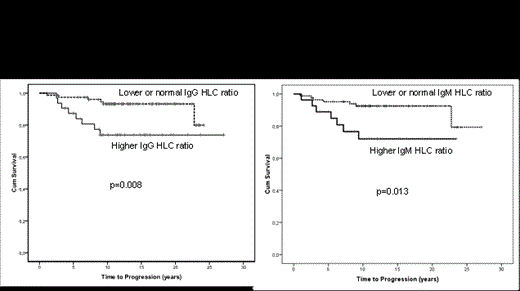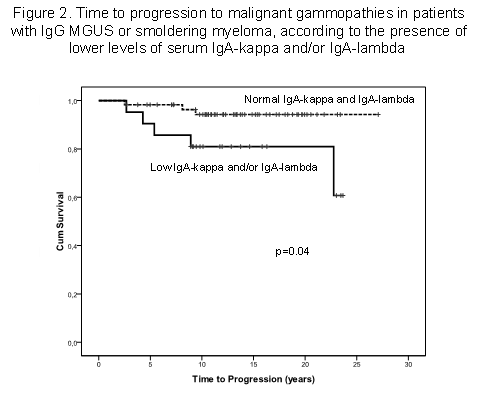Abstract
Asymptomatic monoclonal gammopathies, such as monoclonal gammopathy of undetermined significance (MGUS) and smoldering myeloma (SMM), are clinical conditions that usually precede symptomatic multiple myeloma (MM). However, risk stratification is crucial due to the heterogeneous progression rate among patients with these entities, particularly nowadays when chemoprevention trials are encouraged in high risk patients. In this sense, biomarkers and prognostic index based on tumoral load, M-protein behaviour (evolving vs. non-evolving) and/or immunological status have been developed. In MGUS, serum heavy/light chain (HLC) pairs have allowed the identification of abnormal ratios of involved and non-involved immunoglobins for each specific heavy-chain isotype (IgG-kappa/IgG-lambda, IgA-kappa/IgA-lambda and IgM-kappa/IgM-lambda). The aim of the present study was to investigate the prognostic impact on progression of the isotype-specific suppression of the uninvolved HLC-pair in a series of patients with MGUS and SMM with long follow up.
We retrospectively evaluated 114 patients (median age 61 years; 44M/70F) with SMM (35) and MGUS (79). Median follow up for alive patients was 13 years (range 3 to 27 years). Only 12 patients with SMM accomplished both diagnostic criteria for high risk (bone marrow plasma cell infiltration ≥10% and M-protein ≥30 g/L). Heavy isotype distribution was mainly IgG (71%), IgA (15.8%) and IgM (11.4%); only two patients (1.8%; 1 MGUS and 1 SMM) had only light-chain M-protein. Median bone marrow plasma cell infiltration was 4% and 15% in MGUS and SMM, respectively. 13 patients (11.4%) showed an “evolving” pattern of their serum M-protein.
All patients had an available initial frozen serum sample. Three serum HLC pairs (IgG, IgM and IgA) were evaluated by immunonephelometry (Hevylite; gently provided by The Binding Site, Ltd); HLC kappa/lambda ratio were calculated for each one. Normal values were obtained from 95% normal values reported in healthy donors.
Progression to malignant symptomatic gammopathies was observed in 15 patients (13.2%; 9 SMM and 6 MGUS), mainly to MM (13) with exception of AL amyloidosis and Waldenström's macroglobulinemia in one case each. Risk of progression was 4 times higher in patients with SMM than in those with MGUS (p=0.009), being 8 times higher for high risk SMM (p<0.001). An “evolving” pattern of serum M-protein (p=0.004; HR 4.93, IC 95% 1.7 to 14.8) and a serum M-protein greater than 15 g/L (p=0.01; HR 5.2, IC 95% 1.5 to 18.5) were also associated with higher risk of progression.
Patients with SMM had lower IgG-lambda, IgA-lambda and HLC IgM ratio (p<0.05) than patients with MGUS. IgG HLC ratio was positively associated with bone marrow plasma cell infiltration (r=0.555; p<0.0001). Normal or lower than normal HLC ratios for IgG and IgM were associated with longer time to progression to symptomatic disease (TTP) than higher values (p=0.008 and p=0.013, respectively) (Figure 1). This difference in HLC IgG ratio were even more evident in SMM patients (p=0.002), where only 1 patient with normal or low HLC IgG ratio has progressed. There was also a trend for HLC IgM ratio in this sense (p=0.08). In a multivariate analysis taking into account SMM vs. MGUS diagnosis, “evolving” pattern and HLC IgM and IgG ratio, only the first three variables remained statistically significant for predicting TTP. Suppression of uninvolved HLC pair was more evident in IgG patients, both MGUS and SMM. Hence, any reduction in IgA-kappa or IgA-lambda isotypes was associated with higher risk of progression (p=0.04) (Figure 2).
HLC ratios seem to be a valuable tool in the risk stratification of patients with SMM and MGUS. Suppression of the uninvolved isotype (i.e. uninvolved IgA or HLC IgM ratio in IgG MGUS or SMM) is particularly interesting since this phenomenon has not been previously recognized. The picture of differential clonal suppression of heavy-chain isotypes across risk groups is an issue to be prospectively explored.
Fernández de Larrea:The Binding Site Ltd: Consultancy, Honoraria.
Author notes
Asterisk with author names denotes non-ASH members.



